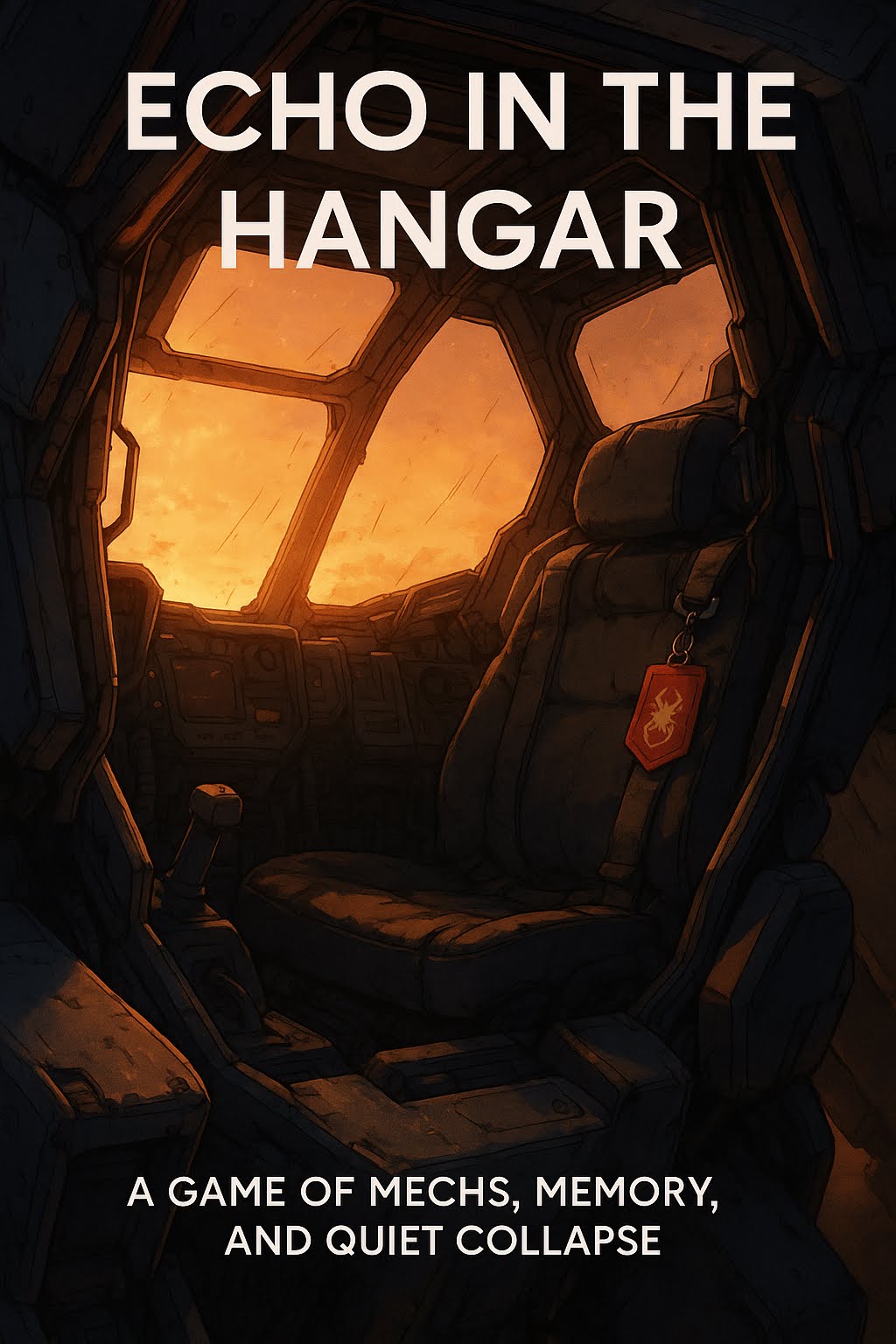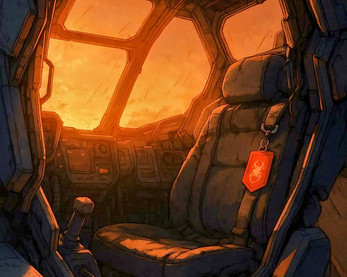Echo in the Hangar
A downloadable book

Fifteen minutes of terror. Twenty-three hours and forty-five minutes of waiting.
You play the pilots, the ghosts, and the echoes of a war that won’t let go.
What is Echo in the Hangar?
Echo in the Hangar is a narrative tabletop roleplaying game about what happens after the mission. Not the explosions, but the silence. Not the heroics, but the rituals. Not the stats, but the Spiral.
Powered by the Stack & Spiral Core Engine, this game uses poetic framing, minimal mechanics, and rotating facilitation to explore memory, loss, and emotional drift.
Play as a broken squadron spiraling together toward collapse. Carry rituals. Trigger flaws. Lose someone. And then return—as an Echo—to whisper from the margins.
Features:
-
Spiral-Based Structure: Play in three phases: Pre-Launch → Debrief → Hangar
-
Lightweight Mechanics: Function Stack, Flaws, and Spiral Points drive emotional tension
-
Echo Protocol: When you're lost, you haunt. Voice still matters.
-
GM-optional: Supports shared facilitation and ritualized scene building
-
Safety & Consent Tools Built-In: Because the mission comes second. The table comes first.
What Makes This Game Different?
Most mech games give you the fifteen minutes of terror.
Echo in the Hangar gives you the rest of the day.
It’s for players who want to spiral together—not through combat, but through absence, memory, and quiet collapse.
This is Vibe RPG’ing: low dice, high resonance, and emotional weight over mechanical reward.
If you’ve ever mourned a callsign more than a character sheet, this is your game.
Credits:
Designed by: HK Kahng (Grey Ledger Society)
With recurring assistance from: ChatGPT, Claude, Gemini, Grok, NotebookLM
“This was never a solo sortie.”
Licensed under Creative Commons Attribution 4.0
Community & Support
Join us at greyledger.org for scenario drops, tone experiments, and new spiral expansions like Echoes Beyond the Hangar.
| Status | Released |
| Category | Book |
| Author | hotel.kilo |
| Tags | emotional-storytelling, Ghosts, indie-rpg, Mechs, narrative-game, no-combat, ritual, safety-tools, Sci-fi, Tabletop role-playing game |
Download
Click download now to get access to the following files:

Comments
Log in with itch.io to leave a comment.
Q1: What is the core emotional and thematic focus of "Echo in the Hangar"?
"Echo in the Hangar" is a game that deeply explores themes of grief, absence, and the breakdown of systems, whether mechanical or emotional. While it delves into heavy topics, the game's tone primer explicitly states a desire to avoid being a "bummer," instead encouraging "gallows humor, Pika mysticism, mech superstition, and improbable friendship." This unique blend allows sessions to range from pensive to strange, highlighting how absurdity and beauty can sustain individuals amidst profound loss and systemic fraying. The game emphasizes collective experience, captured in its mantra: "We spiral together. We witness each other. We carry what we can."
Q2: How do players navigate the emotional intensity of the game?
Players navigate the game's emotional intensity primarily through the "Tone Dial." This tool is used during Session Zero to establish shared emotional expectations for the group, with settings ranging from "Light Spiral" (✨) to "Pensive Core" (🌧), "Bleak Beauty" (🌙), and "Igloo Threshold" (❄). The Tone Dial can drift from session to session, or even scene to scene. If the group crosses into the "Igloo Threshold," which signifies "sublime silence" and "sacred futility," they are encouraged to pause, breathe, and collectively decide whether to remain in that dark space or "spiral toward the next light." This collaborative approach ensures that the emotional journey is consensual and managed by the players together.
Q3: What is the "Shred Index" and how does it impact gameplay?
The "Shred Index" is a crucial shared meter, ranging from 0 to 10, that tracks the squad's collective emotional wear, mission pressure, and quiet breakdowns. It's not about individual damage, but rather the system's overall decay. The index ticks up when a character's "Flaw" is triggered, someone "spirals" emotionally, a character is lost, behavior changes due to absence, a personal object is left behind, or a lie is told to maintain morale. As the Shred Index rises, the game's atmosphere shifts, moving from "Light Spiral" (0-3) to "Pensive Core" (4-6), "Bleak Beauty" (7-9), and ultimately "Igloo Threshold" (10). Reaching 10 signifies a "collapse" where something breaks—a character, a mech, a command, or a bond—leading to outcomes like the "Igloo Threshold," the surreal "Skyfall", or a "Final Transmission."
Q4: Explain the concept of "Echoes" and their role in the narrative.
"Echoes" represent characters who are lost but not truly gone, becoming a haunting presence within the narrative. When a character reaches the "Collapse" state, they can transform into an "Echo" with various modes:
Q5: How do "Functions," "Flaws," and "Spiral Anchors" define a character?
These three elements form the emotional and mechanical core of a character's identity:
Q6: What is "Skyfall" and when might a group engage with it?
"Skyfall" is an optional "lore module" or "post-spiral expansion" that offers a surreal change of pace. It's an uncharted jungle island covered in mech debris, where the local inhabitants, the Pika, believe a crashed pilot (or pilots) is divine. It acts as a "tone palette cleanser" or amplifier for tables that have hit the "Igloo Threshold" and want to pivot into "strange catharsis." In Skyfall, a character who vanished can become a myth, and the game uses "Reverence Meter" and "Echo Points" to track the Pika's belief and the ability to invent dogma or reshape reality through myth. It allows for a dreamlike, absurd, or even return-to-reality experience, filtered through myth and misinterpretation.
Q7: What safety tools are embedded in the game, and why are they important?
"Echo in the Hangar" places a strong emphasis on emotional consent and player safety, stating "The mission comes second. The table comes first." Key safety tools are established during Session Zero and can be adjusted throughout play:
Q8: How does "Echo in the Hangar" acknowledge its inspirations and its unique approach to rules?
The game openly acknowledges its primary inspirations: Dan Abnett's "Interceptor City" for the concept of "Shred" and emotional unraveling as a mechanical cost, and "Mobile Suit Gundam: MS Igloo" for providing the "Spiral's edge" and the "sublime silence" of the "Igloo Threshold." The rulebook explicitly frames itself as "unapologetically, a thank-you note to both."
Furthermore, the game takes a distinctive approach to its rules, declaring itself a "memory system. Not a rules system." It notes that "Fragments shift. Tone drifts. Echoes reword what was once written." If players encounter "contradictions, gaps, or unresolved mechanics," they are encouraged to treat them as "artifacts" and collaboratively resolve them at the table, invent new logic, or "let silence answer instead." This flexible, narrative-first philosophy underscores the game's emphasis on shared storytelling and emotional resonance over strict adherence to mechanics.